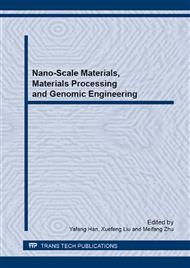p.79
p.84
p.90
p.95
p.100
p.106
p.112
p.117
p.122
Preparation and Properties of Cotton Fiber/Poly(lactic acid) Composites
Abstract:
In order to improve the mechanical properties of poly (lactic acid) (PLA), cotton fiber/PLA composites were prepared by melting compounding and injection molding. The effects of cotton fiber content and coupling agent on mechanical properties, crystalline behavior and interface morphology of the composites were studied by universal testing machine, DSC and SEM, respectively. The results showed that the crystallinity of the composites increased gradually with the increase of cotton fiber content, whereas the mechanical properties of the composites increased firstly and then decreased with further addition of cotter fiber. The composite with 20wt% cotton fiber had an optimal mechanical performance. In addition, with the incorporation of 1wt% coupling agent, the interfacial adhesion between cotton fiber and PLA improved obviously, and the mechanical properties of the composites increased accordingly. Compared with the neat PLA, the tensile strength, flexural strength, flexural modulus and impact strength of the resultant composites were increased by 66.0%, 27.4%, 45.8% and 60.4%, respectively.
Info:
Periodical:
Pages:
100-105
Citation:
Online since:
April 2014
Authors:
Price:
Сopyright:
© 2014 Trans Tech Publications Ltd. All Rights Reserved
Share:
Citation:


